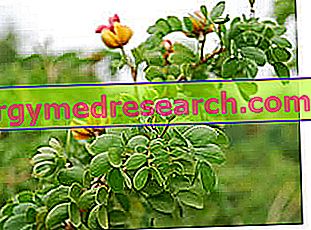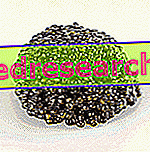Generality
Tendinosis is the chronic suffering of tendons, which results from a degeneration of the normal tendon structure.

Unlike tendinitis, tendinosis is mostly due to the excessive use of the suffering tendon, which makes it an example of functional overload overload.
More frequent in sportsmen, involved in strenuous and elderly jobs, tendinosis mainly affects the tendons located near the large joints (eg: elbow, knee, ankle, etc.) and cause symptoms such as pain, swelling and difficulty in movement.
For the diagnosis of tendinosis, the information provided by the patient is of fundamental importance: the patient's account of the symptoms, the physical examination, the anamnesis and imaging tests such as ultrasound or MRI.
In general, the treatment of tendinosis involves a conservative therapy based on rest, physiotherapy and compression of the painful area; however, in some cases, it may involve the use of other treatments, including surgery.
Short review of what a tendon is
A tendon is a band of fibrous connective tissue, with a certain flexibility and a high content of collagen, which unites a skeletal muscle to a bone.
What is Tendinosis?
Tendinosis is the chronic suffering of a tendon, characterized by a degeneration of the normal tendon structure.
Tendinosis is an example of tendinopathy, ie it is an example of illness or injury to the damage of one or more tendons of the human musculoskeletal system.
Tendinosis should not be confused with tendonitis ; in fact, although both have the tendons of the human body as object, these two conditions present some substantial differences:
- While tendinosis is a chronic suffering, tendinitis is an acute suffering ;
- While tendinitis is characterized by an inflammatory process on one or more tendons (by definition, tendinitis is the inflammation of a tendon), tendinosis is characterized by a structural degeneration, without activation of the inflammatory response, of the tendons or involved;
- While tendinosis is related to repeated microtraumas affecting the affected tendon, tendonitis is the result of a single trauma to the damage of the affected tendon;
- While those suffering from tendinitis benefit from a therapy based on non-steroidal anti-inflammatory drugs (NSAIDs), those suffering from tendinosis tend not to benefit from the use of NSAIDs (indeed, it seems that, in some cases, NSAIDs slow down the healing process).
Features
- Tendinosis is a chronic suffering: it means that it is a condition of long duration and for the healing of which it takes several months of therapy.
- Tendinosis is characterized by a degeneration of the normal tendon structure: it means that the suffering tendon is the victim of an alteration at tissue level, which causes its injury, thickening, hardening with loss of elasticity and / or scarring .

Most common sites of Tendinosis
Any tendon in the human body can be a victim of tendinosis; however, statistics in hand, the tendons which suffer most from this chronic tendinopathy are those having relations with important joints, such as the elbow, shoulder, knee, ankle and hip, and the so-called Achilles tendon .
Tendinosis is more frequent between tendons located near important joints, such as the elbow, shoulder, knee, ankle, hip, and the Achilles tendon.
Causes
The main cause of tendinosis is excessive use of the tendon suffering from pain.
Other major causes of tendinosis are the physical traumas that produce a tendon injury.
How can overuse of a tendon lead to tendinosis?
The expression "excessive use of a tendon" refers to the situation in which there is a continuous motor stimulation of the tendon in question, for the purpose of a precise movement of the body.
Excessive use of a tendon is associated with tendinosis, because it is responsible for serial microtraumas which, in the long run, produce degeneration of the tendon structure.
Overuse tendinosis, therefore, is the result of repeated small stresses on a tendon, which, in the long run, end up undermining the integrity of the tendon structure.
An example of functional overload tendinopathy, overuse tendinosis most often affects tendons located near the large joints (eg: elbow), as they are those most involved in body movement.
Risk Factors: Who suffers the most from Tendinosis?

Most suffer from tendinosis are:
- People who practice sports on a daily basis and athletes .
Why? Practicing sports involves moving the muscles with their tendons and exploiting the mobility of the joints; clearly, the more intense the sport practice is, the more likely it is to incur some injury from overuse of a muscle, a tendon and / or joint.
To minimize the risk of injury, those who train constantly should: set rest periods to be respected; do not overdo your daily physical activity with the hope of getting better results; increase the intensity of the exercise gradually; to rely on or at least seek advice from a person who is specialized in sports of interest; lead a healthy lifestyle.
- Individuals who practice jobs or hobbies that are particularly hard on the body .
Why? So-called manual jobs, as well as hobbies that require some physical stress, sometimes involve excessive use of muscles with their tendons and joints.
- The elderly .
Why? Aging involves a reduction in the flexibility of the attached muscles and tendons, and a loss of mobility on the part of the joints; less flexible muscles and tendons, and less mobile joints favor the onset of musculoskeletal diseases, including tendinosis.
- People with some form of arthritis .
Why? Statistics show that those suffering from arthritis tend to develop tendinosis more frequently.
Most important types of tendinosis
Among the most important and frequent tendinoses, the following are worth mentioning: lateral epicondylitis (also known as tennis elbow ), tendinosis in the patellar tendon (also known as the jumper's knee ) and tendinosis in the Achilles tendon (also known as tendinosis yarrow ).
LATERAL EPICONDYLITIS (OR TENNIS ELBOW)
The tennis elbow is the tendinosis of the tendons that connect the muscles of the forearm to the outside of the elbow (to be precise, to the lateral epicondyle of the humerus).
To suffer most from tennis elbow are:
- Sports practitioners who use a racket (eg: tennis, badminton or squash);
- Practitioners of throwing sports (eg: throwing of the javelin or disc);
- Practitioners of sports such as golf and fencing;
- People who practice a profession that involves repetitive movements of the elbow-wrist-hand complex (eg: masons, plumbers, carpenters, butchers, cooks or carpenters);
- Individuals who play musical instruments for which it is necessary to use lower limbs (eg violinists).
TENDINOSI ROTULEO TENDINOSIS (SALTATOR'S KNEE)
The jumper's knee is the tendinosis of the patellar tendon, which is the tendon that connects the knee patella to the tibial tuberosity of the tibia (one of the two bones of the leg).
The tendinosis in the patellar tendon affects sportsmen above all, in particular those who practice sport in which the leap is frequently performed (eg volleyball, athletics, basketball or soccer).
TENDINOSIS TO THE TENDON OF ACHILLE (OR TENDINOSI ACHILLEA)

Achilles tendinosis is the tendinosis of the Achilles tendon, that is, the tendon that joins the calf muscles to the back bone of the foot known as the calcaneus.
Tendinosis in the Achilles tendon mainly affects:
- Who practices sport;
- Who has the habit of wearing shoes that are inadequate for anatomy and physiology of the foot;
- People with rheumatoid arthritis.
Symptoms and Complications
The typical symptoms of tendinosis are:
- Burning pain and swelling located around the tendon victim of degeneration;
- Pain at the affected tendon that gets worse during and after physical activity (clearly, this refers to a physical activity that involves the aforementioned tendon and the muscle to which it belongs);
- Sense of rigidity affecting the joint connected to the tendon subject to degeneration (readers are reminded that tendinosis mainly affects the tendons located near important joints of the human body);
- Difficulty moving the muscle to which the suffering tendon belongs.
Duration
The symptomatology of tendinosis has a long duration ; after all, tendinosis is a chronic condition.
Complications
Because of their chronic nature and the fact that they limit motor skills, tendinosis can induce feelings of low humor in the affected person, due to movement difficulties and the impossibility of performing activities that were once the order of the day.
When should I go to the doctor?
Tendinosis are conditions for which it is best to contact a doctor with experience in the field as soon as possible.
To know when to contact a doctor, it is essential to evaluate the pain, which, in the case of tendinosis, is constant and persistent despite the rest from any activity that is potentially harmful to the suffering tendon.
Diagnosis
For the diagnosis of tendinosis, the following are essential:
- The patient's account of symptoms ;
- The physical examination . It is the investigation through which the doctor personally evaluates the symptomatology, through the palpation of the suffering area and the execution of some maneuvers (eg: it may require the patient to perform a certain movement with the aching body part);
- The anamnesis . It is the diagnostic evaluation that makes it possible to establish the cause or set of factors that produced the suffering in progress;
- Muscular tendon ultrasound or magnetic resonance to the painful area. These are the exams for diagnostic confirmation; in fact, they provide images of the suffering tendon, showing the area and the type of alteration present.
Therapy
Generally, treating tendinosis involves conservative treatment based on:
- Rest from any activity harmful to the damaged tendon. Leaving the suffering tendon at rest favors the repair of the latter;

- Physiotherapy exercises aimed at improving the flexibility of the suffering tendon and strengthening the muscle to which the aforementioned tendon belongs. Experts have observed that improving tendon tendon tendon elasticity and strengthening the connected muscle promotes the healing process;
- Compression of the painful area. Studies of tendon tendon compression have shown that this treatment promotes repair of damaged tendon tissue.
Did you know that ...
According to some studies, curcumin and vitamin C would have a beneficial effect against tendinosis, as they would promote the production of collagen, thus accelerating the healing process of the tendon structure.
What to do if the Conservative Treatment turns out to be Ineffective?
If conservative tendinosis therapy is ineffective, doctors can draw on more invasive or less conventional treatments, such as:
- Surgery to repair damaged tendon. Surgery is especially helpful in the presence of severe tendinosis. Of the therapies proposed here, as an alternative to conservative treatment, it is certainly the most valid and effective ;
- Injection of corticosteroids at a point adjacent to the damaged tendon. It is a therapeutic option that raises strong discussions among professionals and is increasingly disused, as in some situations it is more harmful than beneficial (it seems to slow down the production of collagen, the fundamental protein of tendons);
- Injection of platelet-rich plasma in an area adjacent to the damaged tendon. According to some studies, this remedy would promote repair and healing of damaged tendon tissue.
Tendinosis does not benefit from anti-inflammatory treatments (eg NSAIDs or ice packs), since, unlike tendonitis, it is not supported by inflammatory processes.
Prevention
Totally eliminating the risk of tendinosis is impossible; it is possible, however, to reduce it more than appreciably, taking care to take breaks from all those motor activities that affect the health of the tendons of the human body.
For an athlete, the prevention of tendinosis is based on: scheduled rest, workload dosage and training variation.
Prognosis
With appropriate therapy, tendinosis can heal; however, patience and compliance with medical indications is needed.
Neglecting tendinosis lengthens the time required for healing the damaged tendon.



